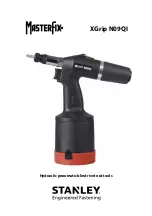
8
•
Do not use the power tool if the switch
does not turn it on and off.
Any power
tool that cannot be controlled with the
switch is dangerous and must be
repaired.
•
Disconnect the plug from the power
source and/or the battery pack from
the power tool before making any
adjustments, changing accessories, or
storing power tools.
Such preventive
safety measures reduce the risk of
starting the power tool accidentally.
•
Store idle power tools out of the reach
of children and do not allow persons
unfamiliar with the power tool or these
instructions to operate the power tool.
Power tools are dangerous in the hands
of untrained users.
•
Maintain power tools. Check for
misalignment or binding of moving
parts, breakage of parts and any other
condition that may affect the power
tool's operation. If damaged, have the
power tool repaired before use.
Many
accidents are caused by poorly
maintained power tools.
•
Keep cutting tools sharp and clean.
Properly maintained cutting tools with
sharp cutting edges are less likely to bind
and are easier to control.
•
Use the power tool, accessories and
tool bits etc. in accordance with these
instructions, taking into account the
working conditions and the work to be
performed.
Use of the power tool for
operations different from those intended
could result in a hazardous situation.
5.
BATTERY TOOL USE AND CARE
•
Recharge only with the charger
specified by the manufacturer.
A
charger that is suitable for one type of
battery pack may create a risk of fire when
used with another battery pack.
•
Use power tools only with specifically
designated battery packs.
Use of any
other battery packs may create a risk of
injury and fire.
•
When battery pack is not in use, keep
it away from other metal objects, like
paper clips, coins, keys, nails, screws
or other small metal objects, that can
make a connection from one terminal
to another.
Shorting the battery terminals
together may cause burns or a fire.
•
Under abusive conditions, liquid may
be ejected from the battery; avoid
contact. If contact accidentally occurs,
flush with water. If liquid contacts
eyes, additionally seek medical help.
Liquid ejected from the battery may cause
irritation or burns.
6.
SERVICE
•
Have your power tool serviced by a
qualified repair person using only
identical replacement parts.
This will
ensure that the safety of the power tool is
maintained.
•
Do not use the power tool in the rain, where
water is splashing, in a wet place, or in a
damp place.
Using the tool in these or similar
conditions will increase the risk of electric
shock, dangerous malfunction, and
overheating.
•
DO NOT DISPOSE OF BATTERY PACKS/
BATTERIES INTO FIRE OR WATER.
Battery
packs/batteries should be collected, recycled
or disposed of in an environmental-friendly
manner.
•
PROTECT THE BATTERY AGAINST HEAT,
ALSO AGAINST CONTINUOUS SUN
IRRADIATION AND FIRE.
There is danger of
explosion.
•
CHARGE THE BATTERY PACK IN A
TEMPERATURE RANGE 5°C (41°F) TO 40°C
(104°F).
•
DO NOT DISPOSE OF POWER TOOLS INTO
HOUSEHOLD WASTE.
According to the
European Guideline 2002/96/EC for Waste
Electrical and Electronic Equipment and its
implementation into national right, power tools
that are no longer usable must be collected
separately and disposed of in an
environmentally correct manner.
•
DEFFECTIVE OR DEAD OUT BATTERY
PACKS/BATTERIES MUST BE RECYCLED
ACCORDING TO THE GUIDELINE 2006/66/
EC.
Содержание Re-Bar-Tier Twintier RB441T CE
Страница 2: ...LOCK Fig 1 22 21 23 Fig 4 Fig 2 Fig 3 Fig 5 Fig 6 2...
Страница 4: ...Fig 22 Fig 23 Fig 24 Fig 25 Fig 26 Fig 27 Fig 28 Fig 29 Fig 30 Fig 31 4...
Страница 23: ...54...









































